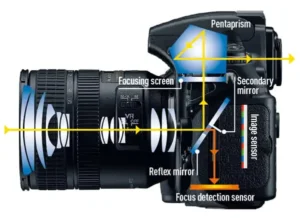A photograph is the result of a process that captures and preserves an image using a camera. The process of forming a photograph involves several elements and stages.
First, light is an essential factor. When light strikes an object, it is reflected or absorbed by its surfaces. A camera captures this light through a lens, which helps focus it and direct its path to the sensor.
The sensor, located inside the camera, is made up of a collection of pixels that convert light into electrical signals. Each pixel records the intensity of the light hitting it and creates a data grid that represents the image.
Once the sensor has recorded the image, the data is processed by the camera’s processor. Here, algorithms are applied to adjust color balance, sharpness and other parameters to improve image quality. This processing step can take place either within the camera itself or later on a computer.
Finally, the image is stored in a digital format such as JPEG or RAW. If conventional film is used, the image is imprinted on the chemically sensitive film. Next, the film is developed to produce a physical photograph.
In summary, the process of forming a photograph involves capturing light through a lens, recording the light by the sensor, processing the data by the processor, and storing the image in a digital or film format. . This process requires a combination of technology, photography skills and creativity to create a memorable image.
As mentioned earlier, the first step in forming a photograph is catching the light. The light coming from the scene passes through the camera lens, which has the task of focusing it on the photosensitive surface, which can be a digital sensor or photographic film.
The digital sensor is composed of a matrix of photosites, or pixels, which convert light into electrical signals. Each pixel records the intensity of light hitting it and converts this data into digital information. The resolution of the sensor, determined by the number of pixels present, affects the quality and detail of the final image.
After the image is captured, the data recorded by the sensor is processed by the camera’s processor. This processing step may include applying algorithms to improve color balance, noise reduction, exposure correction, and other parameters. Some cameras also offer the ability to manually adjust these settings.
Once the image has been processed, it is stored in a digital format. The most common format is JPEG, which uses lossy compression to reduce file size. The RAW format, on the other hand, stores all the information captured by the sensor without compression, offering greater flexibility for post-production.
In the case of traditional film photography, the process is a little different. The light strikes sensitive photographic film, which is coated with light-sensitive chemicals. The film is then developed in a darkroom, where the chemicals react to create the image on the film. Subsequently, the film is fixed and printed to obtain the final photograph.
Either way, the process of forming a photograph requires a balance between technology and creativity. Using the proper photographic tools, understanding camera settings, managing light, and artistic interpretation are all important to achieving high-quality, visually meaningful images.
In conclusion, forming a photograph is a process that involves capturing light through a lens, recording the data by a digital sensor or photographic film, and processing the information by the camera’s processor. Subsequently, the image is stored in a digital format or developed on film.
Technology plays a vital role in the process, providing tools such as digital cameras and high-quality sensors to accurately record the image. However, the photographer’s creativity and expertise are just as important in getting a memorable image. Your choice of framing, exposure, color balance and camera settings influence the final result.
Post-production can be a further step in the formation of a photograph. Digital processing allows you to adjust parameters such as brightness, contrast, saturation and sharpness to enhance the image or create artistic effects. This stage requires skills in using editing software and an artistic vision to achieve the desired result.
Ultimately, forming a photograph is a process that combines technology, technical skills, and creativity to capture and convey a meaningful image. It is an art that allows you to share stories, emotions and personal visions through the skilful use of photographic tools.
